Endodontic Retreatment at VanEndo
With proper care, most teeth that have had endodontic (root canal) treatment can last as long as other natural teeth. In some cases, however, a tooth that has received endodontic treatment fails to heal.
If your tooth has failed to heal or has developed new problems, you have a second chance. An additional endodontic procedure may be able to create a more favorable environment for healing that would allow you to save your tooth.
Your Guide to Endodontic Retreatment
An endodontist is a dentist who specializes in saving teeth. Endodontists become specialists by completing dental school followed by an additional two or more years of advanced training in endodontics. They perform routine, as well as difficult and very complex endodontic procedures, including root canal treatment, retreatment and endodontic surgery. Endodontists are valuable partners on your general dentist's team of trusted caregivers. Your dental team works together to relieve pain, save teeth and provide you with the optimal care that you deserve.
As occasionally happens with any dental or medical procedure, a tooth may not heal as expected after initial treatment for a variety of reasons:
- Narrow or curved canals were not treated during the initial procedure.
- Complicated canal anatomy went undetected in the first procedure.
- The placement of the crown or other restoration was delayed following the endodontic treatment.
- The restoration did not prevent salivary contamination to the inside of the tooth. Human saliva is full of bacteria, which can cause disease if it finds its way into the root canal system.
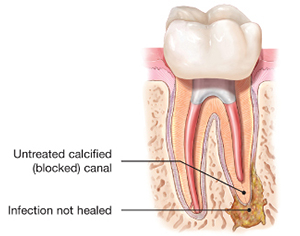
In other cases, a new problem can jeopardize a tooth that was successfully treated. For example:
- New decay can expose the root canal filling material to bacteria, causing a new infection in the tooth.
- A loose, cracked, or broken crown or filling can expose the tooth to new infection.
- A tooth sustains a fracture.
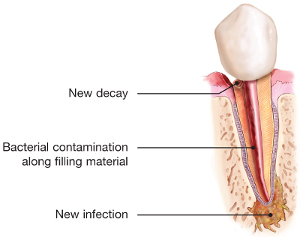
First, the endodontist will discuss your treatment options. If you and your endodontist choose retreatment, the endodontist will reopen your tooth to gain access to the root canal filling material. In many cases, complex restorative materials- crown, post and core material- must be disassembled and removed to permit access to the root canals.
After removing the canal filling, the endodontist can clean the canals and carefully examine the inside of your tooth using magnification and illumination, searching for any additional canals or unusual anatomy that requires treatment.
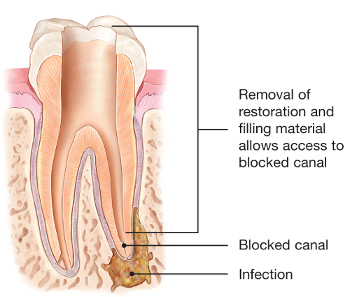
After cleaning the canals, the endodontist will fill and seal the canals and place a temporary filling in the tooth. If the canals are unusually narrow or blocked, your endodontist may recommend endodontic surgery. This surgery involves making an incision to allow the tip of the root to be sealed.
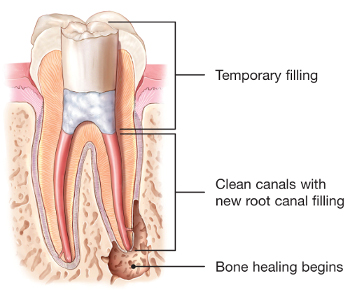
After your endodontist completes retreatment, you will need to return to your dentist as soon as possible to have a new crown or other restoration placed on the tooth to protect and restore it to full function.
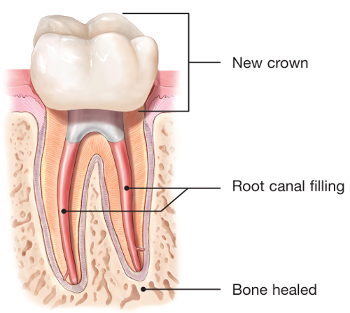
Whenever possible, it is best to save your natural tooth. Retreated teeth can function well for years, even for a lifetime.
Advances in technology are constantly changing the way root canal treatment is performed, so your endodontist may use new techniques that were not available when you had your first procedure. Your endodontist may be able to resolve your problem with retreatment.
Ultimately, your treatment decision should be based on a strategy you have discussed with your dental team (your dentist, endodontist and/or other specialists), and that you agree is best for your overall health.
If retreatment is not an option, endodontic surgery should be considered to save the natural tooth. This surgery involves making an incision to allow access to the tip of the root. Endodontic surgery may also be recommended in conjunction with retreatment or as an alternative. Your endodontist will discuss your options and recommend appropriate treatment.
Though endodontic procedures are intended to help save your tooth, this is not always possible. Often, the only alternative to endodontic treatment is extraction of the tooth. Missing teeth can make you self-conscious, affect your ability to bite and chew, cause other healthy teeth to shift and have a negative impact on your overall health. For these reasons, the extracted tooth should be replaced with an artificial one. Though nothing looks, feels or functions exactly like your natural tooth, dental Implants are a viable alternative to help you maintain a beautiful smile.
No matter how effective tooth replacements are- nothing is as good as your natural tooth. You've already made an investment in saving your tooth. The payoff for choosing retreatment could be a healthy, functioning natural tooth for many years to come.
Nothing looks, feels or functions like your natural tooth.
VanEndo specialists perform routine, as well as difficult and very complex root canal treatment and surgeries.